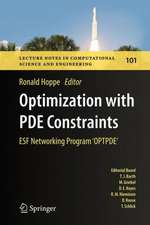Neuromathematics of Vision: Lecture Notes in Morphogenesis
Editat de Giovanna Citti, Alessandro Sartien Limba Engleză Hardback – 20 feb 2014
Experimental data comes from several domains: neurophysiology, phenomenology of perception and neurocognitive imaging. Imaging techniques like functional MRI and diffusion tensor MRI allow to deepen the study of cortical structures. Due to this variety of experimental data, neuromathematematics deals with modelling both cortical structures and perceptual spaces.
From the mathematical point of view, neuromathematical call for new instruments of pure mathematics: sub-Riemannian geometry models horizontal connectivity, harmonic analysis in non commutative groups allows to understand pinwheels structure, as well as non-linear dimensionality reduction is at the base of many neural morphologies and possibly of the emergence of perceptual units. But at the center of the neurogeometry is the problem of harmonizing contemporary mathematical instruments with neurophysiological findings and phenomenological experiments in an unitary science of vision.
The contributions to this book come from the very founders of the discipline.
| Toate formatele și edițiile | Preț | Express |
|---|---|---|
| Paperback (1) | 644.82 lei 6-8 săpt. | |
| Springer Berlin, Heidelberg – 3 sep 2016 | 644.82 lei 6-8 săpt. | |
| Hardback (1) | 649.87 lei 6-8 săpt. | |
| Springer Berlin, Heidelberg – 20 feb 2014 | 649.87 lei 6-8 săpt. |
Din seria Lecture Notes in Morphogenesis
- 18%
 Preț: 1118.45 lei
Preț: 1118.45 lei - 15%
 Preț: 585.73 lei
Preț: 585.73 lei - 24%
 Preț: 708.08 lei
Preț: 708.08 lei -
 Preț: 391.61 lei
Preț: 391.61 lei - 20%
 Preț: 426.75 lei
Preț: 426.75 lei - 18%
 Preț: 731.28 lei
Preț: 731.28 lei - 18%
 Preț: 1223.25 lei
Preț: 1223.25 lei - 15%
 Preț: 643.84 lei
Preț: 643.84 lei -
 Preț: 393.90 lei
Preț: 393.90 lei -
 Preț: 391.22 lei
Preț: 391.22 lei - 15%
 Preț: 643.34 lei
Preț: 643.34 lei -
 Preț: 361.74 lei
Preț: 361.74 lei - 18%
 Preț: 1050.07 lei
Preț: 1050.07 lei - 20%
 Preț: 980.22 lei
Preț: 980.22 lei - 15%
 Preț: 639.59 lei
Preț: 639.59 lei - 18%
 Preț: 885.00 lei
Preț: 885.00 lei - 24%
 Preț: 688.56 lei
Preț: 688.56 lei - 18%
 Preț: 721.68 lei
Preț: 721.68 lei - 24%
 Preț: 727.36 lei
Preț: 727.36 lei - 24%
 Preț: 915.57 lei
Preț: 915.57 lei - 18%
 Preț: 727.18 lei
Preț: 727.18 lei - 18%
 Preț: 1114.83 lei
Preț: 1114.83 lei - 18%
 Preț: 725.61 lei
Preț: 725.61 lei - 18%
 Preț: 837.96 lei
Preț: 837.96 lei
Preț: 649.87 lei
Preț vechi: 764.55 lei
-15% Nou
Puncte Express: 975
Preț estimativ în valută:
124.37€ • 129.36$ • 102.67£
124.37€ • 129.36$ • 102.67£
Carte tipărită la comandă
Livrare economică 14-28 aprilie
Preluare comenzi: 021 569.72.76
Specificații
ISBN-13: 9783642344435
ISBN-10: 3642344437
Pagini: 290
Ilustrații: XVIII, 367 p. 114 illus., 69 illus. in color.
Dimensiuni: 155 x 235 x 27 mm
Greutate: 0.68 kg
Ediția:2014
Editura: Springer Berlin, Heidelberg
Colecția Springer
Seria Lecture Notes in Morphogenesis
Locul publicării:Berlin, Heidelberg, Germany
ISBN-10: 3642344437
Pagini: 290
Ilustrații: XVIII, 367 p. 114 illus., 69 illus. in color.
Dimensiuni: 155 x 235 x 27 mm
Greutate: 0.68 kg
Ediția:2014
Editura: Springer Berlin, Heidelberg
Colecția Springer
Seria Lecture Notes in Morphogenesis
Locul publicării:Berlin, Heidelberg, Germany
Public țintă
ResearchCuprins
Landmarks for Neurogeometry.- Shape, Shading, Brain and Awareness.- From functional architectures to percepts: a neuro mathematical Approach.- Cuspless Sub-Riemannian Geodesics within the Euclidean Motion Group SE(d).- Psychophysics, Gestalts and Games.- Remarks on invariance in the primary visual systems of mammals.- Hebbian Learning of the Statistical and Geometrical Structure of Visual Input.
Recenzii
“This is one of the best books on cortical sensory modeling with the use of partial differential equations, and statistical reasoning included in multidimensional strategies. … I highly recommend this book as a primary reference to vision scientists, students in vision, postdoctoral fellows and senior scientists in the field of cerebral cortical modeling.” (Joseph J. Grenier, Amazon.com, June, 2015)
“This book takes the novel approach of considering the geometry of image processing by the visual cortex system of the brain. … This book is an essential read for anyone conducting serious research in the field of neurogeometry of visual perception.” (R. Goldberg, Computing Reviews, August, 2014)
“This book takes the novel approach of considering the geometry of image processing by the visual cortex system of the brain. … This book is an essential read for anyone conducting serious research in the field of neurogeometry of visual perception.” (R. Goldberg, Computing Reviews, August, 2014)
Textul de pe ultima copertă
This book is devoted to the study of the functional architecture of the visual cortex. Its geometrical structure is the differential geometry of the connectivity between neural cells. This connectivity is building and shaping the hidden brain structures underlying visual perception. The story of the problem runs over the last 30 years, since the discovery of Hubel and Wiesel of the modular structure of the primary visual cortex, and slowly cams towards a theoretical understanding of the experimental data on what we now know as functional architecture of the primary visual cortex.
Experimental data comes from several domains: neurophysiology, phenomenology of perception and neurocognitive imaging. Imaging techniques like functional MRI and diffusion tensor MRI allow to deepen the study of cortical structures. Due to this variety of experimental data, neuromathematematics deals with modelling both cortical structures and perceptual spaces.
From the mathematical point of view, neuromathematical call for new instruments of pure mathematics: sub-Riemannian geometry models horizontal connectivity, harmonic analysis in non commutative groups allows to understand pinwheels structure, as well as non-linear dimensionality reduction is at the base of many neural morphologies and possibly of the emergence of perceptual units. But at the center of the neurogeometry is the problem of harmonizing contemporary mathematical instruments with neurophysiological findings and phenomenological experiments in an unitary science of vision.
The contributions to this book come from the very founders of the discipline.
Experimental data comes from several domains: neurophysiology, phenomenology of perception and neurocognitive imaging. Imaging techniques like functional MRI and diffusion tensor MRI allow to deepen the study of cortical structures. Due to this variety of experimental data, neuromathematematics deals with modelling both cortical structures and perceptual spaces.
From the mathematical point of view, neuromathematical call for new instruments of pure mathematics: sub-Riemannian geometry models horizontal connectivity, harmonic analysis in non commutative groups allows to understand pinwheels structure, as well as non-linear dimensionality reduction is at the base of many neural morphologies and possibly of the emergence of perceptual units. But at the center of the neurogeometry is the problem of harmonizing contemporary mathematical instruments with neurophysiological findings and phenomenological experiments in an unitary science of vision.
The contributions to this book come from the very founders of the discipline.
Caracteristici
Includes helpful algorithms for applications in computer vision and bioengineering Rigorous mathematical approach Written by experts in the field














